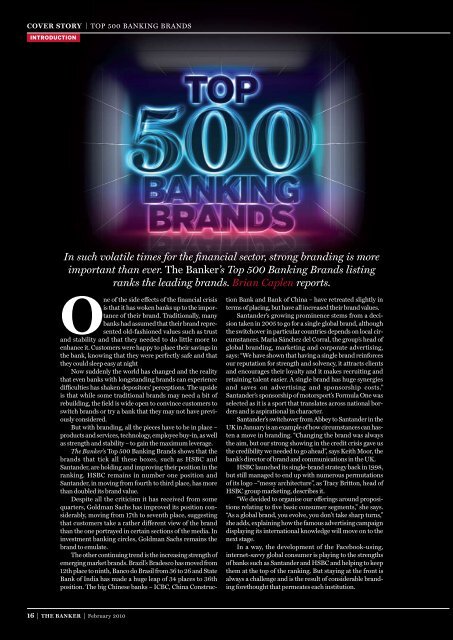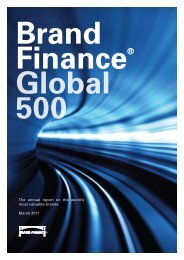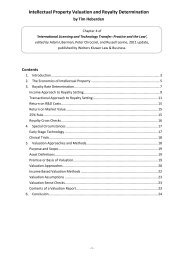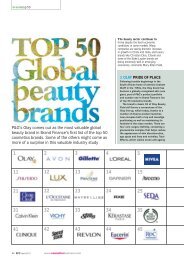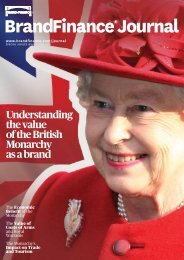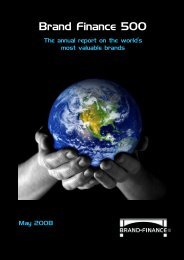You also want an ePaper? Increase the reach of your titles
YUMPU automatically turns print PDFs into web optimized ePapers that Google loves.
cOver sTOry | TOp 500 BANKING BrANDS<br />
introduction<br />
In such volatile times for the financial sector, strong branding is more<br />
important than ever. The Banker’s Top 500 Banking <strong>Brand</strong>s listing<br />
ranks the leading brands. Brian Caplen reports.<br />
<strong>One</strong> of the side effects of the financial crisis<br />
is that it has woken banks up to the importance<br />
of their brand. Traditionally, many<br />
banks had assumed that their brand represented<br />
old-fashioned values such as trust<br />
and stability and that they needed to do little more to<br />
enhance it. Customers were happy to place their savings in<br />
the bank, knowing that they were perfectly safe and that<br />
they could sleep easy at night<br />
Now suddenly the world has changed and the reality<br />
that even banks with longstanding brands can experience<br />
difficulties has shaken depositors’ perceptions. The upside<br />
is that while some traditional brands may need a bit of<br />
rebuilding, the field is wide open to convince customers to<br />
switch brands or try a bank that they may not have previously<br />
considered.<br />
But with branding, all the pieces have to be in place –<br />
products and services, technology, employee buy-in, as well<br />
as strength and stability – to gain the maximum leverage.<br />
The Banker’s Top 500 Banking <strong>Brand</strong>s shows that the<br />
brands that tick all these boxes, such as HSBC and<br />
Santander, are holding and improving their position in the<br />
ranking. HSBC remains in number one position and<br />
Santander, in moving from fourth to third place, has more<br />
than doubled its brand value.<br />
Despite all the criticism it has received from some<br />
quarters, Goldman Sachs has improved its position considerably,<br />
moving from 17th to seventh place, suggesting<br />
that customers take a rather different view of the brand<br />
than the one portrayed in certain sections of the media. In<br />
investment banking circles, Goldman Sachs remains the<br />
brand to emulate.<br />
The other continuing trend is the increasing strength of<br />
emerging market brands. Brazil’s Bradesco has moved from<br />
12th place to ninth, Banco do Brasil from 36 to 26 and State<br />
Bank of India has made a huge leap of 34 places to 36th<br />
position. The big Chinese banks – ICBC, China Construc-<br />
16 | The Banker | February 2010<br />
tion Bank and Bank of China – have retreated slightly in<br />
terms of placing, but have all increased their brand values.<br />
Santander’s growing prominence stems from a decision<br />
taken in 2005 to go for a single global brand, although<br />
the switchover in particular countries depends on local circumstances.<br />
María Sánchez del Corral, the group’s head of<br />
global branding, marketing and corporate advertising,<br />
says: “We have shown that having a single brand reinforces<br />
our reputation for strength and solvency, it attracts clients<br />
and encourages their loyalty and it makes recruiting and<br />
retaining talent easier. A single brand has huge synergies<br />
and saves on advertising and sponsorship costs.”<br />
Santander’s sponsorship of motorsport’s Formula <strong>One</strong> was<br />
selected as it is a sport that translates across national borders<br />
and is aspirational in character.<br />
Santander’s switchover from Abbey to Santander in the<br />
UK in January is an example of how circumstances can hasten<br />
a move in branding. “Changing the brand was always<br />
the aim, but our strong showing in the credit crisis gave us<br />
the credibility we needed to go ahead”, says Keith Moor, the<br />
bank’s director of brand and communications in the UK.<br />
HSBC launched its single-brand strategy back in 1998,<br />
but still managed to end up with numerous permutations<br />
of its logo –“messy architecture”, as Tracy Britton, head of<br />
HSBC group marketing, describes it.<br />
“We decided to organise our offerings around propositions<br />
relating to five basic consumer segments,” she says.<br />
“As a global brand, you evolve, you don’t take sharp turns,”<br />
she adds, explaining how the famous advertising campaign<br />
displaying its international knowledge will move on to the<br />
next stage.<br />
In a way, the development of the Facebook-using,<br />
internet-savvy global consumer is playing to the strengths<br />
of banks such as Santander and HSBC and helping to keep<br />
them at the top of the ranking. But staying at the front is<br />
always a challenge and is the result of considerable branding<br />
forethought that permeates each institution.


